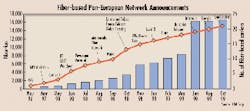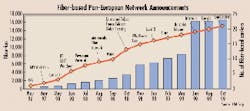Pan-European long-haul fiber demand increased 300%; operators to deploy 16.7 million fiber-km by 2002
Pan-European network operators de ployed 6 million km of fiber in 1999, with a similar level of deployment projected this year. This deployment represents a 300% increase over long-haul fiber installation in 1997. In total, pan-European operators will have deployed 16.7 million fiber-km between 1998 and 2002, a considerable network investment in a telecom market not yet two years old. According to a new study from fiber-optic market research firm KMI Corp. (Newport, RI), the increase is driven by regulatory changes, liberalization, and emerging opportunities to challenge the recently privatized postal, telephone, and telegraph agencies with next-generation networks that connect Europe with the United States.
Since January 1998, 20 pan-European network operators have announced plans to deploy fiber-optic networks, while another group of carriers has announced their intention to lease fiber or capacity to provide services to end users, raising the total number of carriers offering services over fiber to 40. To accommodate capacity demand, fiber-based carriers are installing cables with high fiber counts of typically more than 100, which allows some carriers to sell or lease fiber pairs to others as a means to recoup construction costs.
The new carriers are also specifying nonzero dispersion-shifted (NZDS) fiber, a high-performance fiber optimized for transmitting multiple-wavelength channels over long distances. NZDS fiber will comprise 75% of all new fiber-based pan-European deployments.According to the study, the geographic scope of the new networks and the use of high fiber-count cables are unprecedented in the European telecom market. U.S.-based pan-European carriers such as Level 3, Qwest, MCI WorldCom, and Metromedia Fiber Network are building European networks designed to connect with their North American networks. In addition to backbone networks, carriers such as COLT and MCI WorldCom are extending their reach to business customers by constructing metropolitan area networks (MANs). The number of pan-European-based MANs increased from just one in 1993 to 35 in 1999. The study projects that pan-European carriers will install an estimated 600,000 fiber-km in metro area networks this year.
The study also concluded the following:
- Between 1998 and 2002, 90% of the backbone fiber installed will be deployed by operators that weren't providing long-haul services in Europe before 1998.
- All of the fiber-based pan-European network operators are installing dense wavelength-division multiplexing systems.
- Fiber counts in long-haul networks are typically 96 fibers, while 144-fiber-count cables are being installed in MANs.
The report, "Networks of Fiber-Based Pan-European Carriers: Market Developments and Forecasts," analyzes the volume of fiber installed by pan-European carriers in backbone and metropolitan networks and forecasts future deployment by country and company.
For more detailed information or a copy of the report, visit www.kmicorp.com or call (401) 849-6771.

